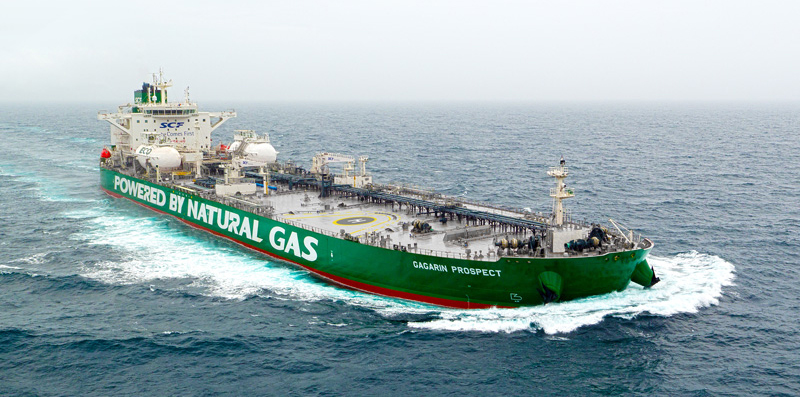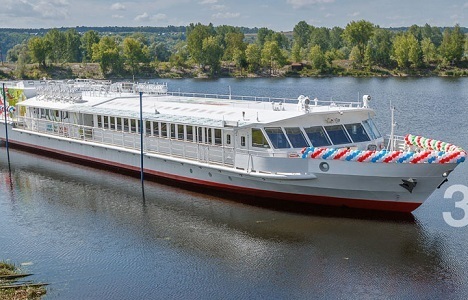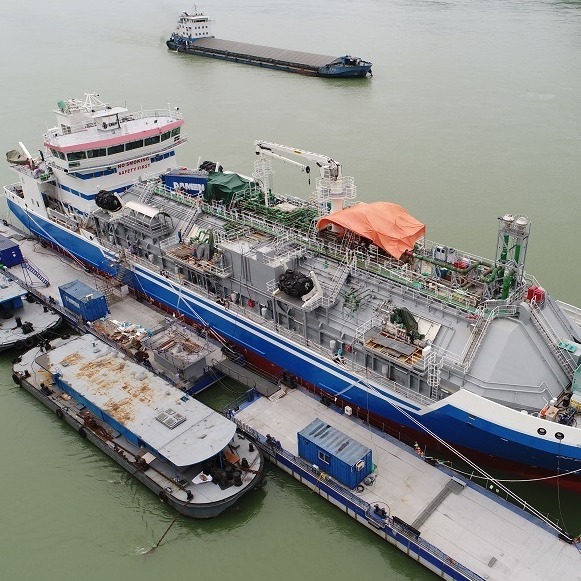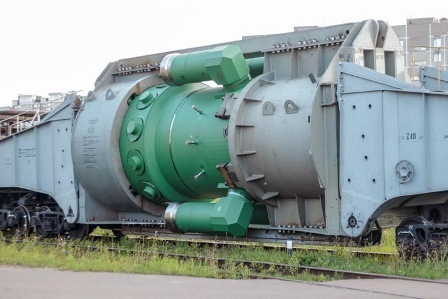
Liquefied natural gas is gradually turning from an alternative into a commonly used fuel. Using LNG as a marine fuel and prospects for introduction of alternatives including nuclear fuel and electricity was discussed at the 4th “LNG Fleet, LNG Bunkering and Alternatives” conference organized by PortNews.
Environmental standards in shipping are permanently getting more stringent worldwide. As Nuritdin Inamov, Director of the International Cooperation Department at the Ministry of Natural Resources, said at the conference, marine fuel requirements are being toughened by both the IMO and the regional organizations such as HELCOM as well as national jurisdictions, hence the need to introduce alternative types of marine fuel.
Meanwhile, there is nothing cheaper than heavy fuel oil today while construction of ships powered by alternative fuels requires additional investments. Therefore, the development of environmentally friendly shipping, globally and in Russia, is not possible without state support measures.
“Despite all advantages provided by liquefied natural gas, cost of LNG-powered ships is 30-40% higher as compared with construction of conventional ships”
The Federal Marine and River Transport Agency (Rosmorrechflot) has resumed its work on the programme aimed at facilitation of LNG-powered shipping, Aleksandr Poshivai, head of the Agency said at the conference. According to him, the programme foresees subsidies to cover the difference between the cost for construction of conventional ships and that for construction of LNG-powered ships which is as high as 30-40% as well as other privileges for ship owners ready to build such vessels.
As of today, a discount is provided for LNG-powered ships calling the port of Primorsk, but that is not enough.
Aleksandr Poshivai has outlined the key challenges of using LNG by water transport in Russia. Among them is the absence of coastal infrastructure, absence of LNG engines of domestic origin, absence of special emergency response forces and facilities, need of certification of specialists according to international standards. The work thereof is underway.
Aleksey Klyavin, President of the Russian Chamber of Shipping, also emphasized the need for state support of ship owners willing to introduce alternative types of fuel.
Vasily Zinin, Executive Director of the National Gas Vehicle Association, shared the NGVA opinion about priority measures of state support towards development of LNG bunkering in Russia.

Chicken-or-egg?
Special ships are needed to develop infrastructure for LNG bunkering while infrastructure is required for construction of such ships. That is a classical ‘chicken-and-egg’ dilemma and only major market players are able to find a solution.
In this context, it should be noted that PAO Sovcomflot, one of the world’s largest tanker companies headquartered in Russia has already accumulated quite an extensive experience in operation of LNG-powered tankers and has defined this type of fuel as the priority for its new vessels.
As Igor Tonkovidov, President & CEO of SCF, said at the conference, CO2 emissions by SCF fleet were reduced by 6.5% in 2018, by 9.1% in 2019 and by 19.2% over 9 months of 2020. Average reduction for 2018-2020 is estimated at 13.3% per year (the dynamics is improving with LNG bunker getting more available). Meanwhile, the efficiency of LNG-powered ships in terms of time charter equivalent is 23% higher as compared with conventional Aframax tankers operated by Sovcomflot.
“The efficiency of LNG-powered ships in terms of time charter equivalent is 23% higher as compared with conventional Aframax tankers operated by Sovcomflot”
“Practical experience of using this type of fuel allows for distinguishing its advantages in operation of ships: safe bunkering, absence of risk to spill the fuel and harm the environment, reliability of equipment, absence of dependence on coastal infrastructure as compared with operation of ships with liquid fuel and scrubbers. Apart from LNG, the market offers other fuels and technologies to meet the IMO requirements on emissions but they either imply using liquid fuel or do not ensure sufficient flexibility and operational convenience, or even neither of them. For example, removal of sulfur oxides while using closed loop scrubber systems lead to accumulation of toxic residues onboard the ships with the ability to discharge them into shore-based tanks for further treatment not always promptly available. Besides, regular acquisition of expandable materials is needed... That results in the increase of operational expenses and lower economic viability as compared with the use of LNG”, told Igor Tonkovidov.
By today, Sovcomflot has successfully conducted over 100 bunkering operations having fueled its ships with more than 43,000 tonnes of LNG. No incidents related to using LNG as a fuel (spills, injures or breakdown) have been registered.
FSUE Rosmorport, another large state company is also building a fleet of LNG-powered vessels. When speaking at the conference, Denis Gursky, deputy head of Rosmorport’s Department for Projects and Shipbuilding Support, told about two duel-fuel ferries currently under construction in the interest of FSUE Rosmorport: the Marshall Rokossovsky and the General Chernyakhovsky. They are intended for the Ust-Luga – Baltiysk ferry line. The ships can be powered by both low-sulphur diesel fuel and by liquefied natural gas. It should be noted that the plans on deployment of those ships in the Baltic Sea are synchronized with those on commissioning of a special bunkering tanker by Gazprom Neft (Gazpromneft Marine Bunker).
As for infrastructure, a small plant for liquefaction of natural gas (660,000 tonnes per year) with Cryogas-Vysotsk terminal put into operation by Novatek has been operating in the port of Vysotsk from April 2019. So far, it is the only terminal offering bunkering of vessels with LNG.
According to Aleksandr Semyonov, Director of the Seaborne Transport Department at NOVATEK, almost all liquefied gas is currently exported from the terminal to Finland, Baltic states, Sweden, the Netherlands and Spain, particularly for bunkering purposes. As of today, Russia has no tankers dedicated for bunkering while there are nine LNG bunkering ships operating in Europe with two vessels to be put into operation by the end of 2020 and two more bunkering ships to be deployed in 2021. They will allow for bunkering of ships with 3 million tonnes of LNG per year which is sufficient to meet the current demand. Therefore, Novatek forecasts the growth of competition among LNG supplies. The company representative says that gas offered by Novatek is of the highest quality with its methane number exceeding 90.

Among the majors in construction of LNG bunkering ships is Damen Shipyards Group. A video about construction of the Optimus, the lead LNG bunkering vessel, was demonstrated during the conference. The vessel of LGC 6000 LNG design intended for bunkering of freight and passenger ships was built at DAMEN Yichang Shipyard in China. The 100-meter-long LNG bunkering vessel with a capacity of 6000 cubic meters meets ice class 1A requirements that lets it operate all year round in the Gulf of Finland and in the northern part of the Baltic Sea. The new vessel has a Green Ship notation. Bunkering vessels of this design will be equipped with a dual-fuel propulsion unit capable of using LNG boil-off gas.
LNG is currently delivered from Cryogas-Vysotsk terminal by two 10,000-cbm ships to large and small terminals in Europe. Novatek is set to put into operation 30,000-cbm gas carrier of Arc4 class under the Cryogas-Vysotsk project in 2022. That plan is linked with the one on launching an LNG terminal in Rostock (Germany) in 2023.
The terminal will accept LNG delivered from Cryogas-Vysotsk terminal by gas tankers and load LNG on bunkering ships and auto trucks for further distribution among European consumers.
Novatek also had a plan to build four LNG-powered icebreakers but the company is currently ambivalent about viability of this project.
“Perhaps, we will not need that number of icebreakers taking into consideration the state programme on upgrading this fleet which is being implemented as scheduled... We are currently estimating the sufficiency of that fleet for our projects with respect of other companies operating in the region, namely Gazprom Neft and Norilsk Nickel. So far, we have no answer if we are going to have them built as well”, said the company representative.
When speaking about LNG, it should be noted that its disadvantage is limited storage life. Therefore, efficient containment is essential. Membrane technology by GTT is acknowledged to be among the best solutions in this respect. As Victor Snegir, Senior Adviser, Gaztransport & Technigaz (GTT) told at the conference, GTT has signed a Technical Assistance and License Agreement (TALA) with the Russian shipyard Zvezda Shipbuilding Complex (Zvezda) for the construction of 15 LNG Carriers (LNGC) fitted with the Mark III membrane containment system. Besides, an agreement has been signed for construction of two floating gas storage facilities for LNG transshipment in Murmansk and Kamchatka (Novatek) and for detailed design and assistance in construction of three gravity-based structures foreseen under the Arctic LNG 2 project.
While on the topic of LNG, it is reasonable to emphasize that its application is not limited by sea-going and mixed sea/river-going transport. LNG-powered river-going passenger vessel Chaika built by Zelenodolsk Plant named after A.M. Gorky (a company of Shipbuilding Corporation “Ak Bars” JSC within Ak Bars Holding) has been put into operation this year. Lenpromavtomatika is involved in the project as a supplier of the system for controlling of the ship’s cryogenic system. Yaroslav Yevdokimov, research engineer at Lenpromavtomatika, told the conference participants about successful experience in automation of the cryogenic system and bunkering, particularly about application of the certified couplings that reduce the risk of incidents during the bunkering process.
Aleksandr Yemelyushkin, Deputy General Director of Shipbuilding Corporation “Ak Bars” JSC, told the conference participants about the construction of the Chaika-LNG ship.
Not by gas alone
Meanwhile, LNG is not the only alternative to conventional fuels. According to Maxim Kulinko, Deputy Head of Rosatom’s Northern Sea Route Directorate, reactor plants RITM-200 installed on the new LK-60 icebreakers can be used efficiently on container carriers and oil tankers.
“Good prospects open through using nuclear power on civil ships”

Moreover, a RITM-200M plant has been developed basing on RITM-200 for an optimized floating power unit (OFPU). Underway is the work on development of a conceptual design for OFPU and a self-propelled power supply ship with two RITM-200M reactor plants.
RITM-200 has been further developed into RITM-400 which is to be installed on the 120 MW Leader icebreaker.
The speaker also emphasized that the spent nuclear fuel can be further used through taking radioisotopes needed for the industrial and medical purposes.
Nuclear fuel provides ships with such advantages as self-sustainability, high capacity, compactness and environmental sustainability. One nuclear fuel loading of RITM-200 is equivalent to 540,000 tonnes of arctic diesel fuel.
“No incidents have occurred during the entire operation period of nuclear-powered icebreakers. The lessons learned from Fukushima have been taken into consideration. In our opinion, that will let us prevent any nuclear accidents”, said Maxim Kulinko.
Meanwhile, the use of nuclear power on civil ships is hindered by doubts about its safety. Many foreign ports are closed for ships with nuclear power units. However, some Asian countries such as China and S. Korea express interest in cooperation in this field, said the speaker.
Besides, Maxim Kulinko said coastal territories in the Arctic are highly interested in the development of infrastructure of bunkering with liquefied natural gas (LNG). “A system of small floating barges should be considered for transportation of LNG by rivers. There are vast prospects: from transition to LNG-fueled road transport and to switching TPPs and boiler stations to LNG which is economically reasonable”, he said.
Aleksey Rakhmanov, General Director of United Shipbuilding Corporation, said in his turn that the shipping industry would complete the transition to electric propulsion within 20-25 years. Among the promising sources of energy he named liquefied natural gas, hydrogen, nuclear power and large capacity batteries.
According to the head of USC, nuclear fuel is an interesting solution as its use throughout a ship’s life cycle is cheaper as compared with LNG. USC also continues its work in the field of using hydrogen and its specialists believe that hydrogen should be produced by air-independent plants rather than stored onboard a ship.
Aleksey Rakhmanov also emphasized that there are no technical obstacles for construction of ships with electric propulsion in Russia.
As Aleksey Palgov, First Deputy to General Director of VOLGOTRANS LLC, told IAA PortNews, VOLGOTRANS has embarked on implementation of its Greenship project that foresees designing, construction and operation of three hybrid ships of the new environmentally sound generation as well as their effective use on the rivers of Russia’s Arctic Zone.
According to him, the company has been working towards implementation of this project from 2016 under the auspices of RF Ministry of Nature. The project is focused on application of the best available technologies in the field of electric propulsion, treatment of ballast and sewage waters, involvement of SCR (Selective Catalyst Reduction) and DPF (Dust Particulates Filter) systems for reduction of NOx, ODS and PAP emissions. Practical implementation of the project was kicked off in June 2020.
As for the environmental aspect, it should be noted that IMO regulations do not take into consideration the impact of the entire life cycle of any fuel. They are only focused on the environmental footprint from operation of ships.
Gennady Yegorov, General Director of Marine Engineering Bureau, emphasized at the conference that CO2 is not the only GHG. Methane, is even more harmful for the ozone layer and considerable amount of it is emitted from engines running on LNG. The equivalent GHG emissions throughout a life cycle is 12% less in case of using methanol and by 4% less in case of using LNG as compared with diesel fuel.
“However, emissions throughout a life cycle of fuel including its production are not considered by IMO and have no impact on selection of marine fuel although methanol looks more environmentally friendly than LNG in this respect”, he said.
Anton Lutskevich, Chairman of ISO Subcommittee on Inland Water Vessels, told about specific features of using different type of fuel.
However, green shipping is not only about the fuel. It is also about materials used on ships. Aleksandr Yevseyev, representative of MAPEI, told about a range of special materials offered by the company for shipbuilding industry. Its products and solutions developed through scientific research focus on the environment protection, ensure safety and health of end users. It is a system that guarantees a certified quality, perfect characteristics, high performance, reliability, durability, easy coating and handling.
Non-dry residue
To summarize the discussion held at the conference it should be noted that nobody is doubtful about the development of alternative energy in the shipping segment. LNG seems to become one of the most popular fuels in the nearest years. Predictably, technologies for using nuclear fuel will also develop, especially in the Russian Arctic, as well as hydrogen and ammonium fuel technologies.
Most probably, electric propulsion will become ubiquitous on ships in the future, particularly through using large capacity batteries as a source of energy. With the technological development they will become smaller and more efficient.
Among the key tasks for a successful introduction of new technologies in the water transport segment of Russia is certainly a consistent dialogue between shipping companies, shipbuilders, component suppliers and state regulators ensuring the required measures of support.
By Vitaly Chernov

news@portnews.ru



